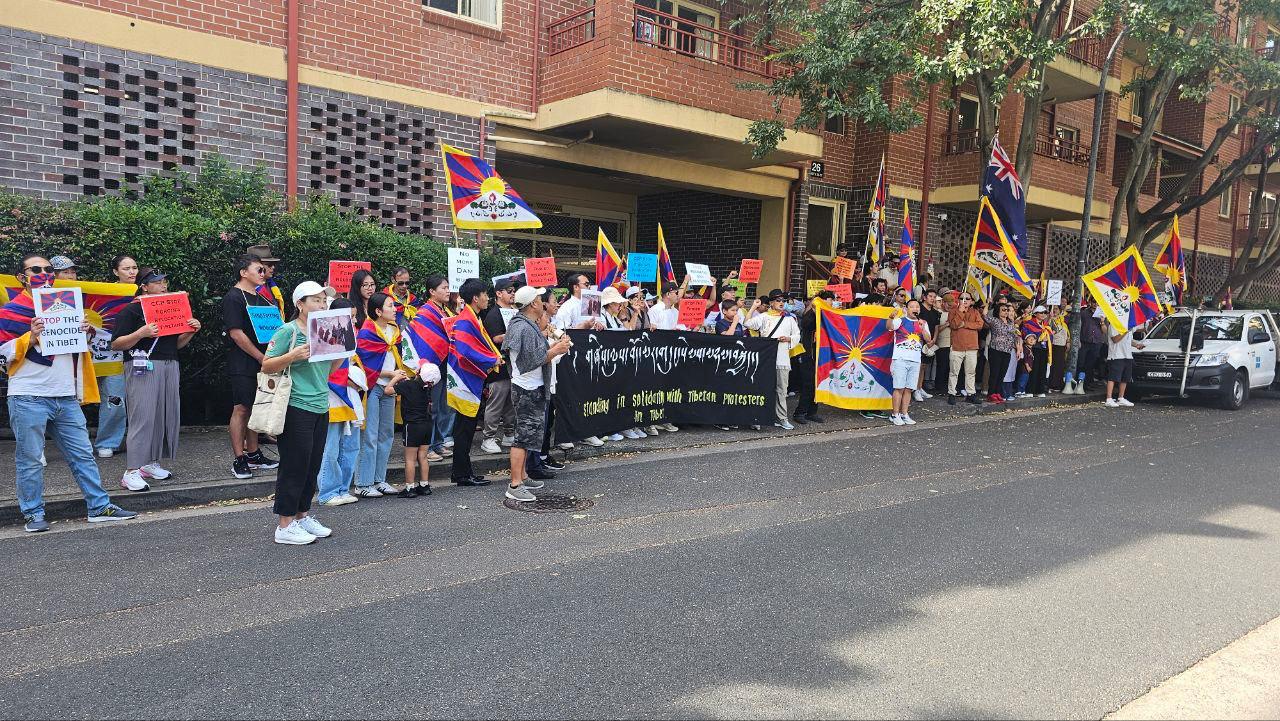Amidst escalating tensions in Dege County of eastern Tibet and strong emotions of solidarity among overseas Tibetans with their fellow Tibetans in the county, approximately a hundred Tibetan demonstrators surged into the Chinese consulate in Sydney, Australia's second-largest city, on March 6, 2024.
The peaceful gathering was attended by various organisations and groups based in the NSW state of Australia, including many members of the Sydney Tibetan Association, the Australia-based Chushi Gangdruk, Regional Tibetan Youth Congress, and others.
Their fervent protest centered on vehement opposition to the Chinese government's unilateral plans to construct the Kamtok dam on the Drichu River in eastern Tibet. The Tibetans in the area assert that the project, undertaken forcefully without the consent of the Tibetan people, entails the forcible resettlement of residents from centuries-old six monasteries and two villages in Dege County, Kham Province of Tibet.
Amidst fervent protests against the hydropower dam projects along the Drichu river in eastern Tibet, over 1,000 individuals, comprising civilians and monks, were subjected to detention. Originating on February 14, 2024, with a gathering of 300 Tibetans at the Dege County Hall, the demonstrations vehemently opposed the proposed dam construction and adamantly demanded the cessation of relocation plans. Escalating tensions followed as Chinese authorities scrutinised Yene and Wonpo monasteries on February 20, inciting monks to implore officials to halt the dam's construction. The crescendo occurred with the arrest of more than 100 Tibetans, including monks, on February 22, succeeded by the detention of over 1,000 additional individuals on February 23, 2024.
The ensuing crackdown, strategically orchestrated to coincide with Tibetan New Year festivities, witnessed law enforcement agencies resorting to coercive measures such as water bullets and electric weapons. This meticulously planned crackdown aimed at stifling dissent and apprehending protesters, resulting in injuries necessitating immediate medical intervention. Simultaneously, the incident underscored profound concerns regarding the Chinese government's rapid advancement of hydropower projects, particularly in ecologically vulnerable Tibetan regions like the Drichu river basin. This relentless pursuit of economic objectives, at the expense of ecological integrity, exacerbates both environmental degradation and humanitarian crises, perpetuating a cycle of displacement and ecological imbalance.
Driven by profound indignation, support, and solidarity, the demonstrators sought to convey their vehement objection to these actions, which they perceive as an assault on their human rights, historical facts, political history, and linguistic cultural heritage. Tibetan people see and recognise these Chinese actions as part of the continued invasion and colonisation by the modern totalitarian regime of China.
The protesters shouted slogans calling for the cessation of the environmentally and culturally destructive dam construction in Dege County, the freedom of Tibet, an end to cultural genocide in Tibet, and the respect for basic human rights that China has proclaimed to uphold in international treaties.
Fearing the global dissemination of the Chinese government's misconduct, exacerbated by crackdowns and disparities within all branches of the regime, including the one-man-controlled government executive, the one-party system, and the judicial system, on-the-ground situations are characterized by political repressions, police state control, and failed policies. This starkly contrasts with proclaimed principles of justice and fairness, leading to fears of a loss of reputation despite proclaimed prosperity.
Driven by apprehensions regarding the global exposure of the Chinese government's misdeeds and exacerbated by crackdowns and inequities in the judicial system, the on-the-ground situations are marked by flagrant instances of unprofessional and inhumane treatment. Consequently, the recourse to imposing total control over the internet for Tibetans within Tibet becomes the sole viable option. This became starkly evident during peaceful protests in Dege County, where internet connectivity was abruptly severed, only to be restored subsequent to the dissemination of videos that had already gained global traction.
For example, the Chinese government imposes draconian control over the entirety of the internet and social media platforms utilised by Tibetans in Tibet, subjecting them to relentless surveillance and monitoring. This engenders a climate of fear, effectively stifling any expression of cultural identity or political dissent within the Tibetan community. Merely posting innocuous content such as a picture of His Holiness the Dalai Lama or engaging in discussions pertaining to Tibet's politics and history can elicit severe repercussions. Those who dare to challenge these oppressive measures are not only at risk of imprisonment but also face the chilling specter of life-long incarceration or even execution. Hence, such ruthless suppression of fundamental liberties warrants unequivocal condemnation and immediate international intervention. Moreover, the families of these individuals are subjected to public condemnation for their alleged involvement in so-called "illegal activities," branded as "splitists" who jeopardize "national unity" and "social stability," thereby deemed threats to "state security."
The unfolding situation in Tibet, particularly the planned construction of the Kamtok dam and the subsequent forced resettlement of Tibetan villages and monasteries, is deeply rooted in a historical context of political repression, social discrimination, and cultural assimilation enforced by the Chinese government. For over 70 years, Tibetans have faced systematic marginalisation, economic exploitation, and environmental degradation, exacerbated by waves of Chinese migration into the region. This has led to growing resentment among the Tibetan population, who feel increasingly marginalized and disenfranchised within their own homeland.
The Chinese occupation of Tibet, which began in 1949 and was completed in 1959, has resulted in immense suffering for the people of Tibet, with over 1.2 million deaths and the near-complete destruction of Tibet's religious and cultural heritage. Prior to Chinese intervention, Tibet existed as an independent Buddhist nation, with a unique cultural identity deeply intertwined with its spiritual practices and connection to the land. The destruction of monasteries, temples, and sacred texts has not only robbed Tibetans of their religious freedom but has also eroded the foundation of their cultural identity. Religion, language, art, and worldview were all integral aspects of Tibetan life, serving as unifying forces within the community and providing resilience in the face of adversity.


![Tibet has a rich history as a sovereign nation until the 1950s when it was invaded by China. [Photo: File]](/images/stories/Pics-2024/March/Tibet-Nation-1940s.jpg#joomlaImage://local-images/stories/Pics-2024/March/Tibet-Nation-1940s.jpg?width=1489&height=878)


















